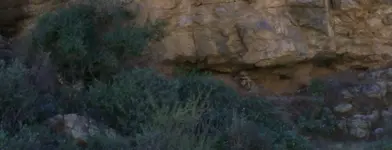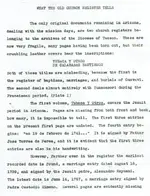Cactusjumper wrote
The obvious question is: If Gibson could find these "Spanish records" in 1878, why is it that only "traditions" can be found today?
Who says that only "traditions" can be found today? Been reading too much of Lamar's rather sweeping statements about "no evidence"? There are fairly obvious reasons why we don't have files full of Jesuit records in AZ - for one, take a look at the Mission 2000 database, you will see what still exists. Do you believe that what they hold today, is very much the whole of the records that existed in the 1700's? Do you suppose that no treasure hunter has gone before us, whom likely took whatever records they could locate? I found incidents from the late 1800's and early 1900's in which Franciscan padres were literally selling off the Jesuit documents they had from the missions - for $1 a page. It seems terrible but they were in need of money at the time, and folks were not so particular about preserving historical documents in that time.
The Mexican city of Canaea claims that they have a mining register which shows the Jesuits having the first mineral claims; it is a bit of a drive for myself, but perhaps someone you know lives closer? Several of the early sources which are saying that records of the Jesuit missions include their mining activities also state that the records are in SPAIN. Again, that is a bit of a drive for me, but perhaps you know someone? Even the small visita churches had written records - but recall how the Jesuit expulsion was executed; they were removed and it was some months before any Franciscans arrived to replace them. It is almost sheer luck that any records remain for us today.
I have pointed this out repeatedly - we do NOT have the whole body of the Jesuit records from any part of Spanish America today; and not only the mining records are missing, records of probate (wills) are also strangely missing. Considering the way the arrest took place in Arizona, one might suspect that the padres had time to conceal or otherwise dispose of the records they didn't wish for the world to see. From many sources we hear that there were records still existing in Arizona in the early period of American involvement, but by around the turn of the century it seems like most of those records have vanished. I would bet that at least several still exist in private ownership.
When researching any treasure legend, in general, the older sources tend to be more correct than later sources. In this case, we cannot expect to have masses of Jesuit testimonies telling all about their mining activities and where any treasures were hidden - but the earliest Anglo-American sources are virtually unanimous in stating that the Jesuits were responsible for a considerable amount of mining and mineral discoveries in Arizona, and in fact even in the time of the Jesuits, the Spanish authorities were convinced that there were considerable treasures hidden which they made energetic searches for, however un-successfully. We know that during the colonial period, large quantities of gold, silver, emeralds, copper etc were being shipped from the Americas to Spain, Portugal and to the Vatican - massive quanitities in fact. These tons of silver bars and gold ingots were coming from mines especially in the later colonial period. We know from the (sparse) reports of pirates and privateers, that the churches were often found to have tremendous treasures - in fact in several cities, special treasure rooms were built under the churches for safe storage of it.
Do you know of any documents which record the church treasures shipped out of the Americas? Are they listed on the ship's manifest from the Atocha, or the Maravilla or the Purisma, or any other Spanish treasure galleon? We have the admission of a Jesuit (Polzer, one whom was a strong deny-er of any Jesuit mines or treasures) that two priests were caught mining, and to be mining there must needs have been mines as well. There are a number of NOT lost Jesuit mines. Should we just dismiss the Indians verbal histories of having been forced to work in the Jesuit's mines as so much fiction to "increase the tourist trade"? We know from the Franciscans that they found the Pimas to have been practically un-educated in the Catholic faith much less the Spanish language, and that they were pleasantly surprised that the new padres were not going to use them like slaves, as they had been under the Jesuits. The Pimas alone, revolted repeatedly against the Jesuits - in 1695, 1734, 1751, and 1756 and killed several of the Jesuits in the process, besides poisoning a couple others. I know that all this is still NOT enough for some folks, whom insist in having the Jesuits come forward themselves with maps and documents admitting to everything, but instead we get wholesale denials from their defenders, always claiming there is "no proof" and "no evidence".
So after taking the very long way round, I must respectfully disagree with the statement of our amigo Cactusjumper, that "all we have are traditions" - we have far more than just stories amigos, sources including the Royal Geographic Society, the Arizona Bureau of Mines, and the US Bureau of Statistics - the Jesuits were mining! Silver mostly, but gold, lead, and copper as well - in other lands we could include emeralds and pearls; the output of those mines served to beautify the Jesuit churches all over the colonies, and the excess was shipped for the Vatican. When the crackdown came, the mines were hidden; some have since be rediscovered, but those stories of the hiding of stacks of silver bars ought not be dismissed out of hand!
Wishing you all a very Happy New Year, and that you find the treasures that you seek.

Oroblanco












